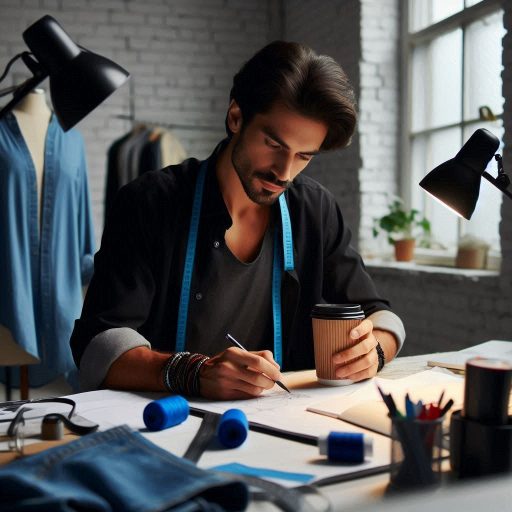Introduction
A mood board is a visual collage used in fashion design to express a concept, theme, or aesthetic.
It typically includes images, color swatches, textures, patterns, and materials that convey the desired look and feel of a collection.
By gathering these elements in one place, mood boards help designers visualize their ideas more clearly and cohesively.
Creating mood boards is vital in the design process for several reasons.
First, they act as a visual reference that guides the overall direction of the collection.
This helps designers stay focused and ensures that every element of the design aligns with the original concept.
Second, mood boards facilitate communication between designers, team members, and clients, making it easier to convey and refine design ideas.
They provide a shared visual language that everyone involved can understand.
Furthermore, mood boards assist in decision-making by highlighting the color schemes, textures, and styles that resonate with the designer’s vision.
They also serve as a source of inspiration and a benchmark throughout the design phases, ensuring consistency and coherence in the final product.
Overall, mood boards are an indispensable tool for turning abstract ideas into tangible fashion designs.
Gathering Inspiration for Fashion Design
Research Current Fashion Trends
To start designing your next collection, begin by researching current fashion trends.
Stay updated with the latest runway shows, industry reports, and fashion week highlights.
Fashion magazines and trend forecasting services like WGSN can provide insights into what’s popular.
Understanding these trends helps ensure your designs are relevant and fresh.
Look for Inspiration in Magazines, Online Platforms, and Social Media
Magazines, online platforms, and social media are treasure troves for inspiration.
Flip through fashion magazines to spot emerging trends and styles.
Websites like Pinterest and Instagram offer endless visual stimuli and can help you discover unique combinations and new ideas.
Follow influencers, designers, and fashion houses to see their latest work and innovations.
Collect Images, Colors, Textures, and Patterns That Inspire You
Create a mood board by collecting images, colors, textures, and patterns that resonate with you.
This visual compilation can be physical or digital, using tools like Canva or Adobe Spark.
Gather swatches of fabrics, photographs, and illustrations that capture your vision.
This collection will serve as a reference throughout your design process, guiding your choices and keeping your creativity focused.
Choosing a Theme
Decide on a central theme or concept for your mood board
Deciding on a central theme or concept for your mood board is essential to ensure cohesiveness and clarity in your design process.
Whether you are working on a seasonal collection, a special occasion outfit, or a specific design project.
Having a clear theme will help you stay focused and inspired throughout the creative process.
Consider the season, occasion, or specific design project
Consider the season when choosing a theme for your fashion mood board.
For example, if you are designing a spring collection, you may want to focus on light pastel colors, floral patterns, and lightweight fabrics.
If you are working on a winter project, you may want to explore rich jewel tones, cozy knits, and luxurious textures.
In addition to the season, think about the occasion for which you are creating your designs.
Are you designing a bridal gown for a summer wedding.
A casual wear collection for everyday wear? A holiday party outfit.
The theme of your mood board should reflect the mood and style of the occasion to ensure your designs are appropriate and impactful.
Ensure the theme aligns with your personal style and brand identity
Moreover, it is essential to ensure that the theme of your mood board aligns with your personal style and brand identity.
Your mood board should be a reflection of your aesthetic preferences, design sensibilities, and creative vision.
By choosing a theme that resonates with you, you will be able to infuse your passion and personality into your designs, creating a cohesive and authentic collection.
Overall, selecting a theme for your fashion mood board is a crucial step in the design process.
Consider the season, occasion, and your style to create a mood board. Use it as a visual guide for your design journey.
Let it direct your color palette, fabric choices, and overall design approach.
Stay true to your vision and let your theme inspire and influence your creative process.
Read: Collaborating with Other Creative Roles
Selecting Visual Elements
Organize and categorize your collected inspiration
Start by organizing and categorizing your collected inspiration into different groups.
This could be based on color, texture, style, or any other relevant factors.
By dividing your images into categories, you can easily see which visuals work well together and which ones might not fit the overall aesthetic you are going for.
Choose key visuals that reflect your theme
Next, choose key visuals that best represent your theme or concept.
These images should be the focal points of your mood board and should clearly convey the mood and inspiration behind your design.
Look for pictures that evoke the emotions you want your audience to feel when they see your collection.
Mix and match images to create a cohesive visual story
Don’t be afraid to mix and match different images to create a cohesive visual story.
Experiment with different combinations until you find a layout that works well together and effectively conveys the message you want to send.
Remember, your mood board is a visual representation of your creative vision, so make sure the elements you choose are in line with your overall design concept.
Read: Historic Costume Design Inspirations
Incorporating Textural Elements
Explore Different Textures and Materials
Start by exploring a variety of textures and materials that align with your design aesthetic.
Whether you’re drawn to soft, flowing fabrics or structured, metallic embellishments, incorporating a mix of textures can create visual interest and depth in your mood board.
Consider Fabrics, Swatches, and Embellishments
Experiment with different fabrics, swatches, and embellishments to add a tactile quality to your mood board.
Fabrics like silk, chiffon, or denim can convey different moods and styles, while sequins, beads, or lace can bring a touch of glamour or whimsy to your design concepts.
Add Tactile Elements to Enhance Depth and Dimension
To enhance the overall visual impact of your mood board, consider adding tactile elements such as fabric swatches, buttons, ribbons, or trims.
These elements not only add texture but also create a sense of depth and dimension, making your design concepts more tangible and engaging.
By incorporating textural elements into your fashion mood boards, you can convey the look and feel of your designs more effectively.
Experiment with different textures, fabrics, and embellishments to create visually compelling boards that showcase your unique design perspective and inspire creativity.
Read: Breaking Down Iconic Movie Costumes
Playing with Colors
Color plays a crucial role in setting the mood for your fashion design.
It has the power to evoke emotions, convey messages, and create a cohesive look.
When creating mood boards for fashion design, experimenting with colors is key to capturing the desired mood.
Experiment with color palettes that evoke the desired mood
Start by exploring different color palettes that resonate with the mood you want to convey.
Whether it’s a bold and vibrant palette for a statement look or a soft pastel palette for a romantic vibe, choose colors that align with the overall theme of your design.
Use color swatches, paint chips, or digital color tools
One way to experiment with colors is by using color swatches, paint chips, or digital color tools.
These resources allow you to visualize how different colors work together and help you create a balanced and cohesive color scheme for your mood board.
Transform Your Career Today
Unlock a personalized career strategy that drives real results. Get tailored advice and a roadmap designed just for you.
Start NowWhen selecting colors for your mood board, think about the emotions you want to evoke.
For example, warm tones like red and orange can create a sense of passion and energy, while cool tones like blue and green can evoke calmness and tranquility.
Consider the psychology of colors and how they impact the mood of your design.
Create a harmonious color scheme that ties all visual elements together
To create a harmonious color scheme, start with a primary color as your foundation. Then, complement it with secondary and accent colors..
This will help create a cohesive and visually appealing mood board that reflects the mood and aesthetic of your fashion design.
Experiment with colors on your mood board to see how different combinations work together. This helps you refine your fashion design palette.
Pay attention to details like color swatches to bring your vision to life.
Create a harmonious color scheme to convey the desired mood through your design.
Read: Top Skills Needed for Art Educators and Instructors

Adding Personal Touches
Include Personal Sketches, Illustrations, or Handwritten Notes
Incorporating your own sketches, illustrations, or handwritten notes can enhance the personal touch of your mood board.
It not only showcases your raw talent but also allows you to convey ideas in an authentic, unfiltered way.
Whether you’re designing for a client or for personal projects, these elements help express your vision in a format that feels more intimate and approachable.
Showcase Your Unique Perspective and Design Ideas
Mood boards are an excellent way to highlight your unique perspective in design.
By curating a selection of images, colors, and materials that resonate with your concept, you create a distinct narrative.
This is your opportunity to let your design philosophy shine and present ideas that reflect your individuality.
Infuse the Mood Board with Your Creativity and Individuality
Your creativity and individuality are key to standing out in any design process.
A mood board offers a platform for this expression.
Use a mix of visual elements, from textures to typography, to bring your personality into the project.
The more your board reflects your unique style, the more it will communicate your creative vision to others.
By adding personal touches to your mood board, you can create a visually compelling and emotionally resonant representation of your designs.
This customization allows you to express yourself authentically through your work.
Personal sketches, illustrations, and handwritten notes can elevate your mood board and make it truly one-of-a-kind.
Arranging the Layout
Arranging the layout of your mood board is crucial for effective visual communication.
Start by organizing visuals in a way that is both appealing and balanced.
A well-arranged layout will help convey your fashion design concepts clearly and attractively.
Create Visual Balance
Visual balance ensures that no part of the mood board feels heavier or lighter than others.
Distribute visuals evenly across the board.
Avoid clustering too many elements in one area, as this can create a chaotic appearance.
Aim for a harmonious balance that guides the viewer’s eye smoothly from one element to another.
Experiment with Different Compositions
Different compositions can bring out various aspects of your design.
Try using a grid layout for a structured, orderly appearance.
This approach allows for easy alignment and organization.
Alternatively, a collage style offers a more dynamic and eclectic feel.
It enables you to blend different visuals together creatively.
A linear arrangement works well for showcasing a sequence or progression.
Test each composition to see which best represents your design vision.
Pay Attention to Spacing
Spacing plays a key role in layout design.
Ensure there is adequate space between visuals to avoid overcrowding.
Proper spacing helps each element stand out and reduces visual clutter.
It also improves the overall readability and effectiveness of your mood board.
Use margins and padding to create breathing room around each image or piece of text.
Focus on Alignment
Alignment helps create a cohesive and organized appearance.
Align visuals along common edges or central lines to establish order.
Consistent alignment contributes to a polished and professional look.
Misalignment can make your mood board appear disjointed and uncoordinated.
Use alignment tools or guidelines to ensure precision.
By carefully arranging the layout, you enhance the mood board’s ability to convey your fashion design ideas.
Experiment with different compositions, maintain visual balance, and focus on alignment and hierarchy for the best results.
Finalizing the Mood Board
Review and Refine
- Take a step back and look at your mood board as a whole.
- Ensure that there is coherence and consistency in the theme.
- Make sure that all the elements work together harmoniously.
Make Necessary Adjustments
- If there are any elements that feel out of place, consider removing or replacing them.
- Hink about the overall impact you want the mood board to have on your design process.
- Adjust colors, textures, and images to enhance the mood and aesthetic you are trying to convey.
Use as Reference
- Once you are satisfied with the final version of your mood board, use it as a reference tool.
- Refer back to the mood board throughout the design process to stay on track and inspired.
- Keep the mood board visible in your workspace to remind yourself of the initial inspiration
By finalizing your mood board with these steps in mind, you can ensure that it serves as a valuable tool in guiding your fashion design process from start to finish.
Conclusion
Creating mood boards for fashion design involves several crucial steps that can significantly enhance your design process.
Start by gathering a wide array of inspirations from various sources.
These can include fashion magazines, online platforms like Pinterest and Instagram, fabric swatches, and even nature.
Collect images, textures, colors, patterns, and other elements that resonate with your design concept.
Mood boards play a vital role in the fashion design process.
They are not just a collection of images but a dynamic tool that generates and organizes ideas.
By translating abstract concepts into visual formats, mood boards help you maintain a clear focus and ensure that all design elements align with your overarching theme.
Encourage yourself to experiment with various combinations and styles.
The process of creating a mood board should be an exploration of creativity.
Don’t be afraid to try unconventional pairings or to shift elements around.
This experimentation can lead to unexpected and exciting design breakthroughs.
Enjoy the process of curating and arranging your mood board.
It’s a chance to delve into your design concept deeply and refine it through visual exploration.
[E-Books for Sale]
The Big Book of 500 High-Paying Jobs in America: Unlock Your Earning Potential
$19.99 • 500 High-Paying Jobs • 330 pages
Explore 500 high-paying jobs in America and learn how to boost your career, earn more, and achieve success!
See All 500 High-Paying Jobs of this E-Book
1001 Professions Without a Degree: High-Paying American Jobs You Can Start Now
$19.99 • 1001 Professions Without a Degree • 174 pages
Discover 1001 high-paying jobs without a degree! Unlock career tips, skills, and success strategies for just $19.99!




